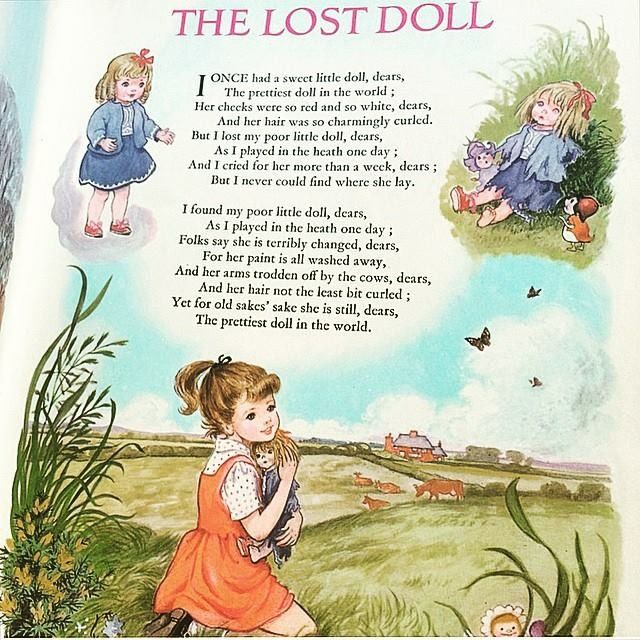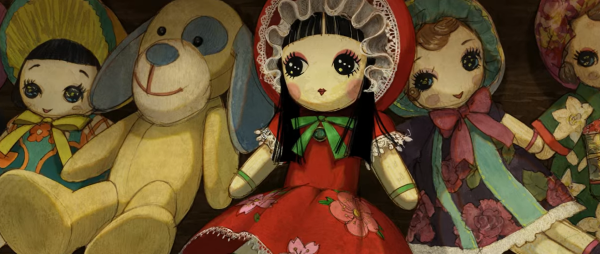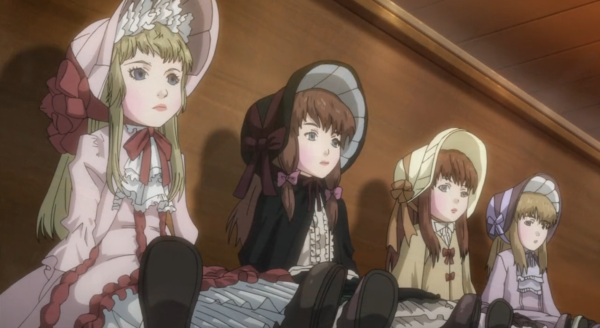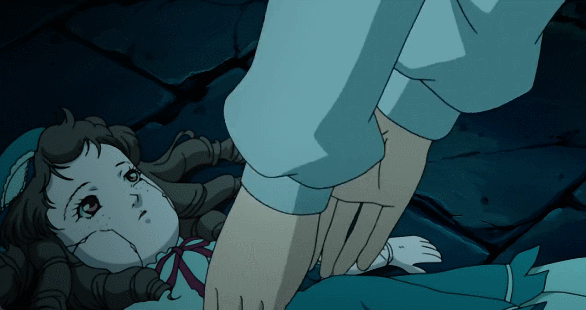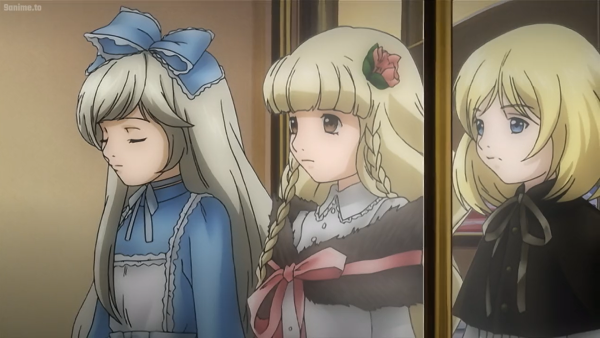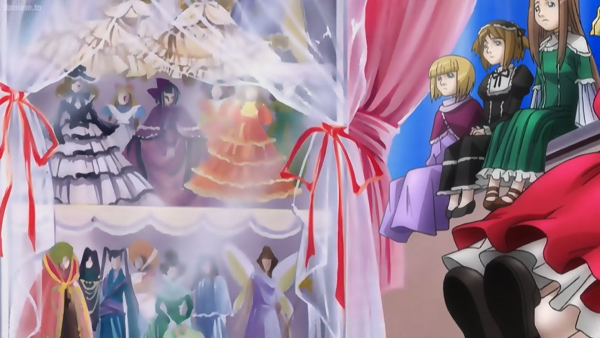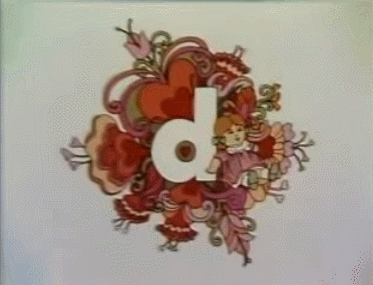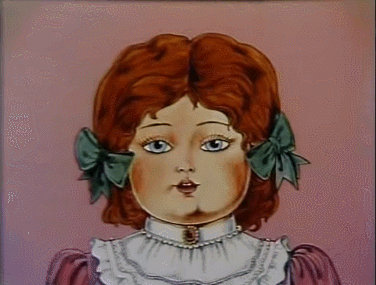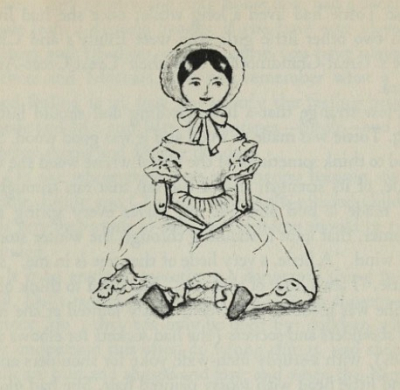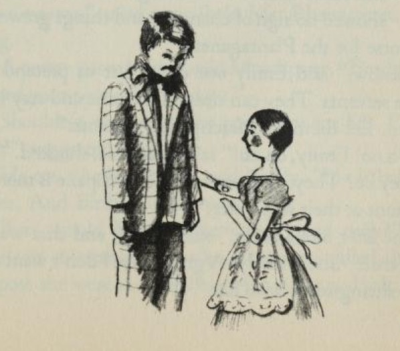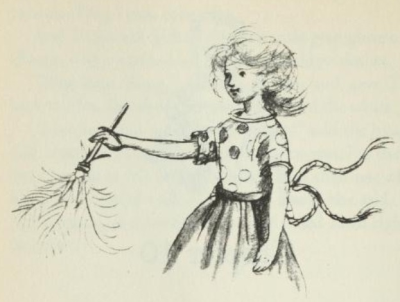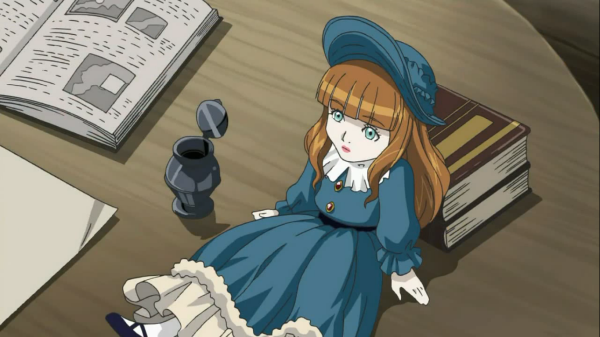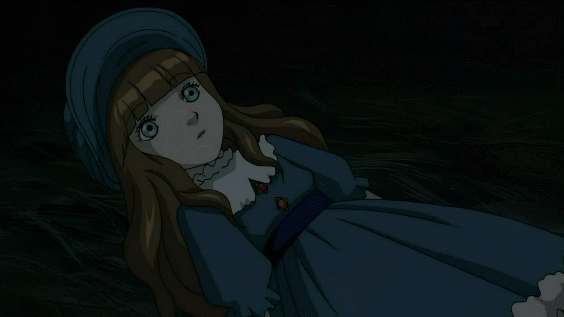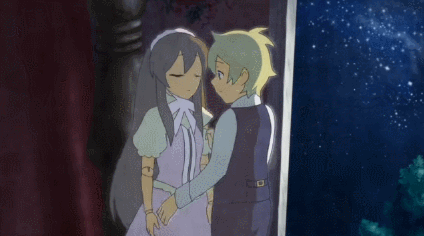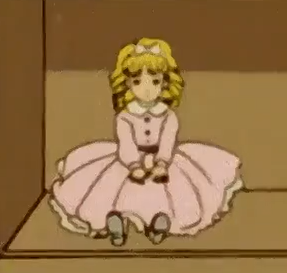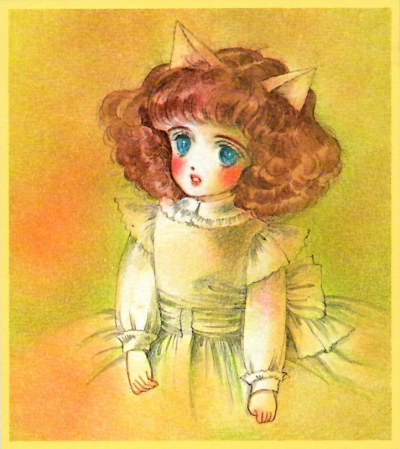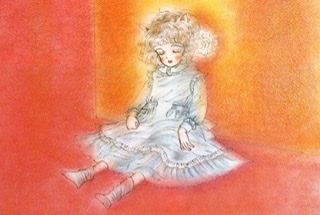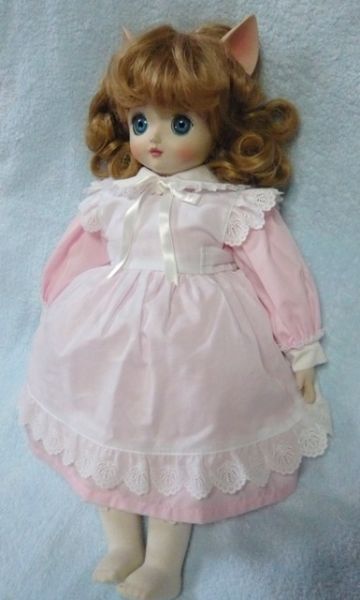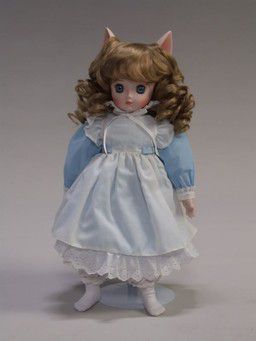Dolls in Media
Creepy depictions of antique dolls abound, which is a shame, they're very beatiful and artfully made, so I thought I'd collect pretty and positive depictions of them! They'e often depicted faithfully in anime, with rosy cheeks, painted lips, and defined noses, that they amusingly wind up less stylized (therefore, much more realistic) than the human characters! While the primary focus of this page is European bisque dolls, there might also be vintage wooden, celluloid, cloth or rag dolls, and even dolls from other parts of the world, as well as an honourary mention or two who is not quite a bisque doll, but looks very much like one!
A departure from the usual western style antique dolls featured on this page, but also an example of western fashion influence in Japanese dolls! They are soft, plush dolls made from Japanese fabric, with Japanese patterns, like other traditional Japanese toys (like the otedama typically juggled by young girls, which are made from silk scraps of old kimono), but in the form of European clothes or Japanese clothes with western details such as lace and bonnets added, influenced by the European fashions and dolls that entered Japan during the Meiji (1868-1912) and Taisho (1912-1926) periods... the latter era is where this animated short from Studio Colorido, about a cameraman's efforts to make people smile, in the years leading up to and during WWII. GOSICK
Rozen Maiden
A nameless, freckled bisque doll with long, brown ringlets from the first season of Rozen Maiden. All the main characters, aside from human protagonist Jun (and his older sister, Nori) are near-immortal, sentient, antique ball-jointed dolls, with magical powers, as long as they still have their Rosa Mystica rings, which the source of their power. When Rozen Maidens die, they revert to resembling ordinary dolls, rather than lifelike (if very tiny, doll-sized) girls—like this poor fallen doll seen in Suigintou's dream world. The sight of this doll disturbs the Rozen Maidens, being their equivalent of a corpse, and they express pity for her. Each of the Rozen Maidens have their own unique style of dress and unique personalities (Hina-Ichigo dresses like a Sweet Lolita and is very cheerful and exuberant, child-like, scribbling in crayon on everything; Shinku, meanwhile, dresses in a very elegant Classic Lolita style, is proud and restrained, but also exhibits high emotional intelligence—despite her outburts—and helps Jun understand others and helps others understand him in turn, Souseiseki dresses in Ouji/Prince or Boy Style Lolita fashion, she even speaks boyishly, so she's easily mistaken for a boy, and a senile old man sees her as his lost son...).
(A doll with long straight brown hair, light skin, hazel eyes, and frilly orange headdress and matching orange frills criss-crossing down her black dress and orange-hemmed capelet, sitting on a shelf from the dollmaker's shop in the second season of Rozen Maiden.)
(Numerous dolls with varying shades of blonde hair (ash, platinum, and gold?) sitting on a shelf in the dollmaker's shop in the second season of Rozen Maiden.)
(Numerous dolls decorating the shelves of doll-obsessed working woman Kusabue (Micchan) Mitsu's room and some sitting in her windowsill in the second season of Rozen Maiden.) Sesame Street - Daddy Dear
There's an old-fashioned doll in this adorable and imaginative Sesame Street segment (note: music) from 1972, focusing on words beginning with the letter D, with a song that portrays a back-and-forth between a very inquisitive little girl and her frustrated, but patient, father trying to get her to go to sleep. He calls her "little dolly" at the end and we see the same doll at the beginning and end, when she finally goes to sleep, so she represents the daughter, as neither father nor daughter are shown.
The Dolls' House The Dolls' House by Rumer Godden is a thoughtful book with wonderfully unique main characters who are all dolls (their current owners, two little girls named Emily and Charlotte, appear now and then too, but are written more like secondary characters) and is told from the point of view of dolls. Dolls are depicted as timeless and unaging beings (no matter how many years go by, they are always the same age they were made to resemble) who can only wish and hope their owners respond to those wishes. Our main characters, Tottie and her mix-and-match family of dolls, live in a shoebox at the start of the story and very much wish to have a proper doll house, especially as the winter months begin... Tottie tells them of a Victorian dollhouse that belonged to the girls’ grand-aunt she once lived in. You can borrow the book from the Internet Archive's library (signing up is free!), the old version illustrated by Tasha Tudor is available.
The main character is Tottie, a wooden Dutch doll. She's a very sensible and strong-willed doll, an old hand-me-down.
Tottie's doll father, Mr. Plantagenet, is quiet, nervous, and troubled, as he used to belong to two rowdy boys who mistreated him, tore a glued instrument out of his hand, chipping his paint, and their dog chewed off his foot... he was then abandoned for years and now hates the dark and drafts.
Tottie's doll mother is Birdie, a celluloid (early plastic) doll who came as a gift in a Christmas cracker, covered in feathers, looking like a dancer. She's flighty and easily distracted, but easily satisfied with simple things. and she seems to have a fixation (it honestly reads to me like a special interest) in birds and feathers. She's fascinated with anything related to them and even misses a giant mess all around because all she can see and focus on is a bird. She also has a resilient spirit and is a wonderful mother.
Tottie's doll brother is Apple, a ruddy-faced, adorably adventurous, plush velvet 3-year-old boy who often gets into trouble, falling into places he shouldn't.
Lastly, there is Marchpane, a very vain and very self-absorbed antique doll, finely dressed in a wedding dress and with real hair elegantly pleated, who once occupied the dollhouse belonging to the girls' grand-aunt.
There are other minor characters, like the dolls Tottie meets at the exhibit, including a very proud French walking doll who mocks and teases Tottie for being such a cheap, tiny thing, and a more timid wax doll who is more gentle with Tottie and falls absolutely in love with the museum caretaker's daughter... but while the little girl is similarly taken with her, the wax doll is only meant to be displayed and sadly cannot be played with. Dolls in this story seem to envy ones that have children who play with them (it's a little like Toy Story in that way!), being played with and spending their days in a dollhouse makes them feel alive.... being shut up in a museum, only admired, makes them feel like mere "things," even the vain and proud walking doll calls such a place "cold." A stop-motion adaptation was aired in the 80's on British television channels and continued to air on syndication into the 90's, it seems the villainous doll's antics haunted a lot of kids in those eras! A Little Princess It is difficult to imagine Sara Crewe—the quiet, thoughtful, imaginative, once-spoiled-and-doted-on child who copes with the loss of her old life by imagining she is a princess and telling stories—without her beloved doll, Emily, one of her father's last gifts to her and one of the only possessions she was allowed to keep. Preferring books to dolls, she seldom buys any and when she does, it's a great affair. She names Emily before she "meets" her and they visit several stores, trying to find her. "Perhaps she had known her. She had certainly a very intelligent expression in her eyes when Sara took her in her arms. She was a large doll, but not too large to carry about easily; she had naturally curling golden-brown hair, which hung like a mantle about her, and her eyes were a deep, clear, gray blue, with soft, thick eyelashes which were real eyelashes and not mere painted lines." ~~~ "So Emily was bought and actually taken to a children's outfitter's shop, and measured for a wardrobe as grand as Sara's own. She had lace frocks, too, and velvet and muslin ones, and hats and coats and beautiful lace-trimmed underclothes, and gloves and handkerchiefs and furs." ~~~ "He got out of his bed in the middle of that night and went and stood looking down at Sara, who lay asleep with Emily in her arms. Her black hair was spread out on the pillow and Emily's golden-brown hair mingled with it, both of them had lace-ruffled night-gowns, and both had long eyelashes which lay and curled up on their cheeks. Emily looked so like a real child that Captain Crewe felt glad she was there." 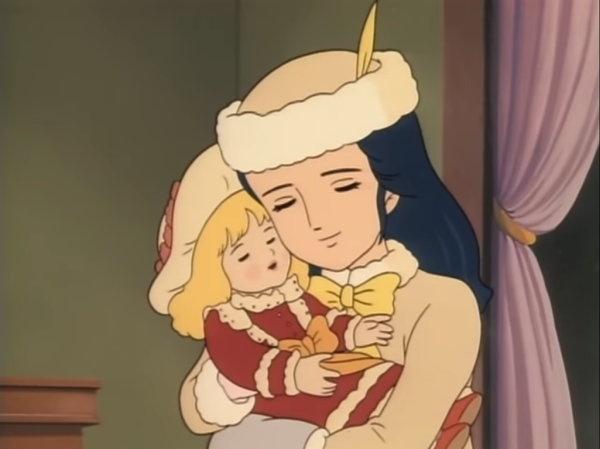 This is how Sara and Emily are depicted in the World Masterpiece Theater* anime, A Little Princess Sara. Emily is said to be a French Jumeau doll in the anime, with expressive eyes and an open mouth. Here are some other dolls shown in the shops visited in episode 2: 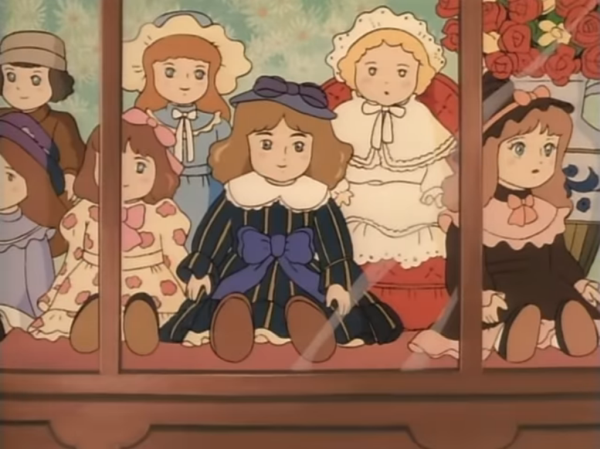 
Shoujo Cosette
In the most recent World Masterpiece Theater anime, Shoujo Cosette, an anime based on Victor Hugo's Les Misérables, Jean Valjean purchases a doll for Cosette, which she names Catherine and always carries with her. Ikoku Meiro no Croisee
Some dolls we see in episode 8: Nursery, where Alice shows Yune the nursery she played in as a child. little heart
A short and sweet independant animation about two ball-jointed dolls from two shops at opposite sides of the street (you can watch it on the animator's YouTube.). The setting is vaguely vintage, western-inspired, but doesn't seem to fit a specific era as far as I can tell. The focus is on the dolls and their relationship, anyway... it's very cute! When Marnie Was There
Maple Town
Honourary Mentions:
While not intended to be a doll herself, Suwano Chibineko, the heroine of The Star of Cottonland, is as tiny as a doll, with a dreamy airbrushed blush and painted lips, giving her a very bisque doll-like appearance—as she's actually a kitten who imagines she could one day be human! The cats in this classic shojo series are stylized as tiny, cat-eared and cat-tailed humans (nekomimi), but in the more innocent way the concept began rather than the more sexualized depictions common now. This similarity likely inspired the decision to make a couple of collector's item bisque dolls based on her.
|
